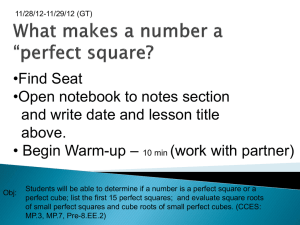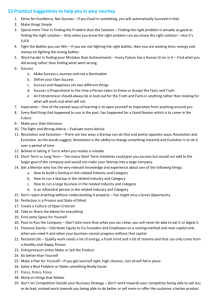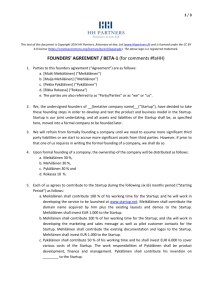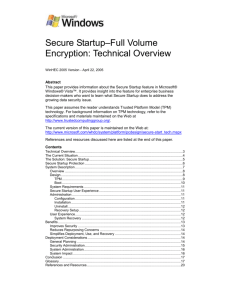docx - National Assessment & Testing
advertisement
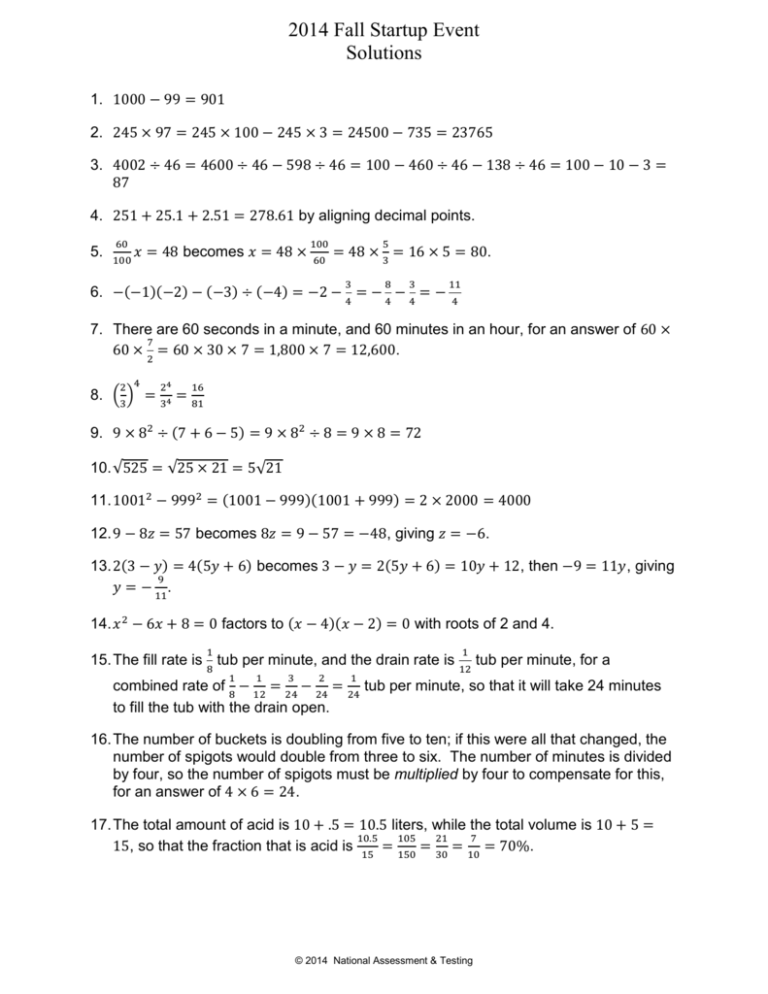
2014 Fall Startup Event Solutions 1. 1000 − 99 = 901 2. 245 × 97 = 245 × 100 − 245 × 3 = 24500 − 735 = 23765 3. 4002 ÷ 46 = 4600 ÷ 46 − 598 ÷ 46 = 100 − 460 ÷ 46 − 138 ÷ 46 = 100 − 10 − 3 = 87 4. 251 + 25.1 + 2.51 = 278.61 by aligning decimal points. 5. 60 100 𝑥 = 48 becomes 𝑥 = 48 × 100 60 5 = 48 × 3 = 16 × 5 = 80. 3 8 3 6. −(−1)(−2) − (−3) ÷ (−4) = −2 − 4 = − 4 − 4 = − 11 4 7. There are 60 seconds in a minute, and 60 minutes in an hour, for an answer of 60 × 7 60 × 2 = 60 × 30 × 7 = 1,800 × 7 = 12,600. 2 4 24 16 8. (3) = 34 = 81 9. 9 × 82 ÷ (7 + 6 − 5) = 9 × 82 ÷ 8 = 9 × 8 = 72 10. √525 = √25 × 21 = 5√21 11. 10012 − 9992 = (1001 − 999)(1001 + 999) = 2 × 2000 = 4000 12. 9 − 8𝑧 = 57 becomes 8𝑧 = 9 − 57 = −48, giving 𝑧 = −6. 13. 2(3 − 𝑦) = 4(5𝑦 + 6) becomes 3 − 𝑦 = 2(5𝑦 + 6) = 10𝑦 + 12, then −9 = 11𝑦, giving 9 𝑦 = − 11. 14. 𝑥 2 − 6𝑥 + 8 = 0 factors to (𝑥 − 4)(𝑥 − 2) = 0 with roots of 2 and 4. 1 1 15. The fill rate is 8 tub per minute, and the drain rate is 12 tub per minute, for a 1 1 3 2 1 combined rate of 8 − 12 = 24 − 24 = 24 tub per minute, so that it will take 24 minutes to fill the tub with the drain open. 16. The number of buckets is doubling from five to ten; if this were all that changed, the number of spigots would double from three to six. The number of minutes is divided by four, so the number of spigots must be multiplied by four to compensate for this, for an answer of 4 × 6 = 24. 17. The total amount of acid is 10 + .5 = 10.5 liters, while the total volume is 10 + 5 = 10.5 105 21 7 15, so that the fraction that is acid is 15 = 150 = 30 = 10 = 70%. © 2014 National Assessment & Testing 2014 Fall Startup Event Solutions 84 18. Because the numbers sum to 84, the numbers must be equidistant from 2 = 42, such as 0 & 84 or 40 & 44. Because the numbers differ by 36, they must each be 36 = 18 from 42, so that the smaller number is 42 − 18 = 24. 2 19. The 𝑥-intercept is on the 𝑥-axis, where 𝑦 = 0, so 3𝑥 − 4(0) = 3𝑥 = 24, so 𝑥 = 8 for an answer of (8,0). 𝐴 3 20. The slope of the line 3𝑥 + 4𝑦 = 24 is − 𝐵 = − 4, so the slope of a perpendicular line 4 would be the negative reciprocal, 3. 21. √4 − (−2)2 + (−7 − 3)2 = √62 + 102 = 2√32 + 52 = 2√9 + 25 = 2√34 22. |𝐴𝑥+𝐵𝑦+𝐶| √𝐴2 +𝐵2 = |1+2+2| √12 +12 = 5 √2 = 5√2 2 23. 𝑦 = 3𝑥 + 1 goes through (0,1) and heads up & right and down & left, so that it will avoid quadrant IV. 𝑏 −28 24. The axis of symmetry is 𝑥 = − 2𝑎 = − 2×2 = 28 4 = 7. 25. The vertex is on the axis of symmetry, 𝑥 = −3, so 𝑦 = (−3)2 + 6(−3) − 11 = 9 − 18 − 11 = −20, for an answer of (−3, −20). 26. When two-digit numbers are reversed, the increase or decrease is always nine times the difference between the two digits. Our difference of 72 means we’d like a 72 difference between digits of 9 = 8, so that our number must be 19. 27. His path can be thought of as four rectangles, two measuring 30 by 1 and two measuring 18 by 1, for an area of 60 + 36 = 96. 𝐾 28. The 20 kg costs 𝐷 dollars, which is 100𝐷 cents. The 𝐾 kg should cost 20 times as 𝐾 much, which would be 20 × 100𝐷 = 5𝐾𝐷. 29. 120 Wombats is 40 × 3 Wombats, so could be exchanged for 40 × 4 = 160 Vultures. The 160 Vultures is 16 × 10 Vultures, so could be exchanged for 16 × 21 = 336 Slugs. 𝑞 2−𝑞 1 30. 1+𝑞 = 5−𝑞 becomes 5𝑞 − 𝑞 2 = 2 + 𝑞 − 𝑞 2 , then 4𝑞 = 2, giving 𝑞 = 2. 31. We can write 𝑃 = 3𝑂 and 𝑃 + 4 = 2(𝑂 + 4) = 2𝑂 + 8, then substitute to get 3𝑂 + 4 = 2𝑂 + 8, so that 𝑂 = 4 and thus 𝑃 = 3 × 4 = 12. 32. FOIL gives (𝑛 + 3)(2 − 5𝑛) = 2𝑛 − 5𝑛2 + 6 − 15𝑛 = −5𝑛2 − 13𝑛 + 6. © 2014 National Assessment & Testing 2014 Fall Startup Event Solutions 1 1 33. 𝐴 = 2 ℎ𝑤 = 2 × 3 × 4 = 2 × 3 = 6 34. Each of the three sides is 5, for a perimeter of 3 × 5 = 15. 35. We can draw an altitude to the side measuring 6, creating two right triangles with legs of 3 and hypotenuses of 7. The Pythagorean Theorem gives the altitude as 1 1 √72 − 32 = √49 − 9 = √40 = 2√10, so that the area is 𝐴 = 2 ℎ𝑤 = 2 × 6 × 2√10 = 6√10. 36. If there’s an obtuse angle, the triangle is called “obtuse”. 37. A polygon with four sides is called a “quadrilateral”. 38. Like a rectangle, a parallelogram’s perimeter is 2𝑎 + 2𝑏 = 2(𝑎 + 𝑏) = 2(8 + 9) = 2 × 17 = 34. 39. 𝐴 = 𝜋𝑟 2 = 𝜋 × 102 = 100𝜋 1 1 40. 𝑉 = 3 𝑠 2 ℎ = 3 × 92 × 8 = 3 × 9 × 8 = 27 × 8 = 216 41. A seven-sided polygon is called a “heptagon” or a sometimes “septagon” (a Latin/Greek mashup). 90 9 42. The ratio of the areas is 40 = 4. This is the square of the ratio of the dimensions, 9 3 3 which would be √4 = 2, so that the perimeter of the larger pentagon will be 2 × 30 = 3 × 15 = 45. 3 43. The volume of a cube is 𝑠 3 , so that 𝑠 = √512 = 8. The surface of the cube is six squares, so the area is 6 × 82 = 6 × 64 = 384. 44. Δ𝐴𝐸𝐷 is similar to Δ𝐴𝐶𝐵, so we can write 5 7 = 5+𝑛. Cross-multiplying gives 25 + 9 5𝑛 = 63, which becomes 5𝑛 = 63 − 25 = 38 38, giving 𝑛 = 5 . A 7 3 5 B E 2 D n 45. Heron’s Formula gives 𝐴 = √11 × 2 × 4 × 5 = 2√110, so that the altitude 1 to the sides measuring 9 should satisfy 2√110 = 2 × 9𝑎, giving 𝑎 = 46. Stewart’s Theorem gives 32 × 4 + 𝑘 2 × 2 = 32 × 6 + 2 × 4 × 6, which becomes 36 + 2𝑘 2 = 54 + 48 = 102, then 2𝑘 2 = 66 and 𝑘 2 = 33, giving 𝑘 = √33. © 2014 National Assessment & Testing C 4√110 9 . 4 k 2 3 3 2014 Fall Startup Event Solutions 3 1 47. The goat can graze 4 of a circle with radius 8, as well as 4 of a circle with a radius of 1 3 1 1 8 − 4 = 4 and 4 of a circle with a radius of 8 − 6 = 2, which is 4 × 64𝜋 + 4 × 16𝜋 + 4 × B 4𝜋 = 48𝜋 + 4𝜋 + 𝜋 = 53𝜋. A 10 48. We can write 10 9 8 = 𝑗 , then cross-multiply to 72 get 10𝑗 = 72, which gives 𝑗 = 10 = 9 8 36 5 D . j C 49. Have of the chord in question is a leg of a right triangle with a hypotenuse and other leg that are 𝑅 and 𝑟, respectively, so we can write ℎ2 + 𝑟 2 = 𝑅 2 , then ℎ2 = 𝑅 2 − 𝑟 2. By a strange coincidence, the area of the annulus between the two circles is 49𝜋 = 𝑅 2 𝜋 − 𝑟 2 𝜋 = 𝜋(𝑅 2 − 𝑟 2 ), so that 49 = 𝑅 2 − 𝑟 2 . Combining these two equations gives ℎ2 = 49, then ℎ = 7, so that the chord’s length is 2 × 7 = 14. 50. 𝑓 + 𝑔 + ℎ = 𝑓 + 180 = (180 − 𝑎) + 180 = 360 − 𝑎 = 360 − 57 = 303 a b d c e 51. The formula for the number of diagonals in a convex 𝑛(𝑛−3) 9×6 polygon is 2 = 2 = 9 × 3 = 27. f h g 52. If the three lines bound a triangle, the regions created are the triangle, one outside each side, and one outside each vertex, for a total of 1 + 3 + 3 = 7. 1 53. At 6:00 the angle is 180°. In ten minutes, the minute hand moves 6 × 360 = 60° and 1 the hour hand moves 6 × 30 = 5°, so that at 6:10 the smaller angle is 180 − 60 + 5 = 125°. 3 54. If there are 216 cubes, then the large cube was cut into √216 = 6 sections. Any cube that is part of the four inner sections in all dimensions (43 = 64 cubes) will have no red paint, so that 216 − 64 = 152 cubes have some red paint. 55. 𝑖(2 − 3𝑖)(4𝑖 + 5) = 𝑖(−7𝑖 + 22) = 7 + 22𝑖 56. 2𝑖 3 + 5𝑖 6 − 9𝑖 10 = −2𝑖 − 5 + 9 = 4 − 2𝑖 57. Starting to complete the squares, 𝑥 2 − 6𝑥 is part of (𝑥 − 3)2 and 4𝑦 2 + 4𝑦 is part of 1 2 1 4 (𝑦 + 2) , so the center is at (3, − 2). 58. Because 28 = 256, log 2 256 = 8 59. 71 = 7, 72 = 49, and 73 = 343, with the latter being big enough to push 𝑔 > 1000, so ℎ − 6 = 3, giving ℎ = 9. © 2014 National Assessment & Testing 2014 Fall Startup Event Solutions 60. 𝑓 is 24 6 = 4 times 𝑔, so when 𝑔 = 18, 𝑓 = 4 × 18 = 72. 61. The domain is the inputs (𝑐) that don’t “break” the function. The square root is what could be broken, if it tried to take the square root of a negative number. Thus, our domain is 30 + 𝑐 − 𝑐 2 ≥ 0, which factors to (5 + 𝑐)(6 − 𝑐) ≥ 0, which happens when 𝑐 ≤ 6 or 𝑐 ≥ −5, which is [−5,6] in interval notation. 62. There are three 20 second intervals in each minute, so there are 5 × 3 = 15 in five 1 15 minutes, leaving (2) 1 3 × 4096 × 1000 = (2) × 1000 = 125 g of the sample. 63. There will be terms from 𝑎45 𝑏 0 to 𝑎0 𝑏 45 , which is 45 + 1 = 46 terms. 5 1 1 1 1 64. 64−2 = 8−5 = 85 = 215 = 1024×32 = 32768 65. 1236 = 1 × 36 + 2 × 6 + 3 = 36 + 12 + 3 = 51 66. In base four, the digits represent 1’s, 4’s, 16’s, 64’s, etc. There are three 64’s in 234, leaving 42. There are two 16’s in 42, leaving 10. There are two 4’s in 10, leaving 2. Thus, 23410 = 32224 . 67. You can do arithmetic in any base without converting, although division is hard because it helps to have your multiplication facts memorized, which I only have in base 10. Adding 4567 and 5427 , we start with the units digit. 6 + 2 = 8 = 117 , so we write a 1 and carry a 1. In the sevens digit, 5 + 4 + 1 = 10 = 137 , so we write a 3 and carry a 1. In the 49’s digit, 4 + 5 + 1 = 10 = 137 , so we write a 3 and carry a 1, getting 13317 . 68. 684 = 22 × 171 = 22 × 32 × 19 69. 440 = 22 × 2 × 5 × 11 = 23 × 51 × 111 , so the sum of the factors is (1 + 2 + 4 + 8)(1 + 5)(1 + 11) = 15 × 6 × 12 = 90 × 12 = 1080. 70. 1200 = 22 × 52 × 22 × 3 = 24 × 31 × 52 . Any multiple of 8 must have 23 in its prime factorization, so the factors of 1200 can have 0 or 1 extra 2 (2 choices), 0 or 1 3 (two choices), and 0 or 1 or 2 5’s (three choices). Thus, there are 2 × 2 × 3 = 12 such numbers. 71. 24 and 45 have a GCF of 3, so the LCM will be 24×45 3 = 8 × 45 = 360. 72. There are 99,999 − 9,999 = 90,000 five-digit numbers, and 4 × 5 × 5 × 5 × 5 = 2,500 that have only even digits, leaving 90,000 − 2,500 = 87,500 that contain at least one odd digit. © 2014 National Assessment & Testing 2014 Fall Startup Event Solutions 73. 21 ends in 2, 22 ends in 4, 23 ends in 8, 24 ends in 6, 25 ends in 2, 26 ends in 4,etc. This pattern repeats every four terms, so 28 ends in 6, 212 ends in 6, and 216 ends in 6, so 215 ends in 8. 74. The sixth term is five terms away from the first, so will be 11 × 25 = 11 × 32 = 352. 75. The differences are 3, 5, 7, 9, ?, ?, 15, 17, …, the missing terms of which appear to be 11 & 13, making the missing term of the original sequence 31 + 11 = 42 = 55 − 13. 76. A harmonic sequence is the reciprocals of an arithmetic sequence, so our sequence 1 1 1 1 goes 2, 5, 8, 11, … 77. The sum from 1 to 79 is 79(79+1) 2 = 79 × 40 = 80 × 40 − 40 = 3160. 78. The twelve smallest odd counting numbers add up to 122 = 144. 79. The eight smallest positive perfect cubes add up to the square of the sum of the 8×9 2 eight smallest counting numbers, which is ( 2 ) = (4 × 9)2 = 362 = 1296. 80. There are 26 red cards, and 6 other face cards (J, Q, K in clubs & spades), for a 32 8 probability of 52 = 13. 81. There are 25 = 32 ways to flip five coins, and 5𝑐3 = 10 5 5×4 2 = 5 × 2 = 10 ways to get three heads, for a probability of 32 = 16. 82. Nine can be rolled as 6&3 two ways and 5&4 two ways, for a total of four ways. 4 1 There are 6 × 6 = 36 ways to roll two dice, for a probability of 36 = 9. 83. 12 𝑐 5 = 12×11×10×9×8 5×4×3×2 = 11 × 9 × 8 = 11 × 72 = 792 84. The two artists can be arranged in 2! = 2 ways, Huey can be arranged in 4! = 24 ways, and Ms. Dion can be arranged in 5! = 120, for a total of 2 × 24 × 120 = 24 × 240 = 5760 ways. 85. There are 36 − 9 = 27 people who drank something, 25 of which had Poke, so that means 27 − 25 = 2 of them had ONLY Cepsi. The other 16 − 2 = 14 Cepsi drinkers also had Poke, meaning they drank both. 86. Of the ten segments on a path, three must go down, so 10×9×8 there are 10𝑐3 = 3×2 = 10 × 3 × 4 = 120 ways. © 2014 National Assessment & Testing 2014 Fall Startup Event Solutions 87. Put the breadcrumbs and 4 − 1 = 3 pebbles in a bag and start drawing. Give breadcrumbs to the first duck until you get to the first pebble (toss it aside!), then give breadcrumbs to the second duck until you get to the second pebble, etc. There 13×12×11 are 13𝑐3 = 3×2 = 13 × 2 × 11 = 2 × 143 = 286 ways to do this. 88. < 9, −3 > − < 1,2 > = < 8, −5 > 6 3 4 3 89. | | = 4𝑤 − 6 = 0 becomes 4𝑤 = 6, giving 𝑤 = 4 = 2. 2 𝑤 90. Eliminating the 2 & 14, 3 & 9, 4 & 9, 6 & 9, and 6 & 7 leaves a single 7. 91. 𝑈 𝑐 is numbers without an odd digit (all evens), so 𝑉 ∩ 𝑈 𝑐 is two-digit multiples of six with only even digits, so is 24, 42, 48, 60, 66, and 84, which is 6 elements. 92. The primes less than 20 are 2, 3, 5, 7, 11, 13, 17, and 19. Of these, we need exactly one of 13, 17, or 19, and any of 2, 3, 5, or 7. There are 3𝑐1 = 3 ways to pick one of 13, 17, or 19, and there are 24 = 16 ways to choose some of 2, 3, 5, or 7, for an answer of 3 × 16 = 48. 93. There are 3 × 7 = 21 1x1 squares, 2 × 6 = 12 2x2 squares, and 1 × 5 = 5 3x3 squares, for a total of 21 + 12 + 5 = 38. 94. This kind of problem is typically trial and error. 2 × 3 − 4 = 2 and 2 × (4 − 3) = 2, with other solutions possible. 95. The cotangent is the reciprocal of the tangent, so it is the adjacent side over the 4 opposite side. The smallest angle is opposite the smallest side, so the answer is 3. 96. In the third quadrant, the cosine will be negative, and the magnitude will be 1 √1 − sin2 15 = √1 − 16 = √16 = √15 , 4 for an answer of − √15 . 4 1 1 8 97. sin(2𝑟) = 2 sin 𝑟 cos 𝑟 = 2 sin 𝑟 × 3, and sin 𝑟 = ± √1 − cos 2 𝑟 = ± √1 − 9 = ± √9 = ± 2√2 2√2 1 4√2 3 3 3 9 , for an answer of 2 × (− )× =− . 98. The denominator has an 𝑟 7 term, while the numerator only has an 𝑟 5 term, so the denominator will get large faster than the numerator, making the limit 0. 1 1 1 99. 𝑞(𝑝) = 5(7𝑝 + 9)2 , so 𝑞 ′ (𝑝) = × 5(7𝑝 + 9)−2 × 7 = 1 − 2 9 2 = 35 2 1 ×3= 35 2 35 6 . © 2014 National Assessment & Testing 1 (7𝑝 + 9)−2 , so 𝑞 ′ (0) = 35 2 × 2014 Fall Startup Event Solutions 4 8 4 100. ∫2 (6𝑥 + 𝑥) 𝑑𝑥 = 3𝑥 2 + 8 ln 𝑥|42 = 3(42 − 22 ) + 8(ln 4 − ln 2) = 3 × 12 + 8 ln 2 = 36 + 8 ln 2 © 2014 National Assessment & Testing



